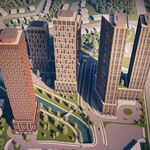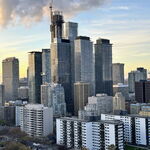By Shawn Micallef, National Post
The westbound TTC stop at Parliament and Carlton is not the place to fall in love with Toronto’s streetcars. If you stand there long enough, a red rocket will eventually turn off Gerrard and glide up the street, ready to deliver you to points west. But it’s a hard corner to wait at — you can only see a few hundred metres down the track — and you’ve got to trust that another car is always just around the bend.
The longer you wait, the more invested you feel in waiting longer. It must be just around the corner by now. When it isn’t, the initials “FS†stamped on the nearby TTC schedule that promise “Frequent Service†seem more likely to stand for “Frequent Sucker.†That’s you. Or me.
And when I feel like a sucker I start walking west on Carlton, losing sight of the Parliament stretch of tracks. Sometimes it will round the corner a half-minute later and I’ll be mid-block and miss it, while other times I’ll stomp, mutter and swear all the way to Yonge Street before I see a streetcar.
Why, exactly, do I buy a Metropass every month? It’s at this point of incendiary exasperation that the people who say Toronto’s streetcars are antiquated and should be removed — tracks and overhead wires included — start to sound like reasonable people.
This is a moment of weakness, though, so pay no attention to them, for they are philistines. To rip out Toronto’s streetcar system would remove the glue that holds the centre of this city together. The network of rails is infrastructure built to last on a grand scale. Should we ever abandon
Toronto such as they have Detroit, Buffalo and other shrunken U.S. cities, and then let 10,000 years of weather erode and wear the city down, the tracks will still be here like an indestructible city skeleton laying in the dust of our civilization. Those philistines say buses are more nimble and can maneuver around cars making left hand turns, and that they don’t require a massive capital investment, but those rails are an investment in the very idea of Toronto.
Buses lack the elegance of the streetcars that navigate like giant street ships through Toronto, their permanent courses set for the long haul.
During a snowstorm, try riding up near the front of a car before the salt trucks have a chance to turn it all into dirty slush. While other vehicles slip and slide, unsure of the road beneath, the streetcars drive a steady and straight line down the middle, instantly organizing the chaos around them.
Our current streetcars are built like tanks and weigh too much — damaging the rails and neighbouring masonry — but that solid chunk-a-chunk, chunk-a-chunk sound that your body feels more than your ears hear it, and the way the sidewalk vibrates under your feet as they roll by, is one of the few times Toronto reaches back and touches us physically. Up above, the wires are the city’s electric nervous system, continuously running, waiting for a streetcar to tap it for energy. They’re like Toronto’s ceiling, marking where the city ends, and atmospheric wilderness begins.
Toronto is undergoing a rail renaissance. City Hall is promoting its Transit City plan that would have light rail extend well outside of the former City of Toronto boundaries, while Metrolinx, the regional transportation authority, just unveiled a plan that would continue to drive those rails out into the 905. There are even passionate debates in both Internet and sidewalk forums on whether Eglinton should have light rail or a subway of its own.
Across North America cities are looking to return to urban rail transit, yet for decades Toronto had one of the only robust streetcar networks on the continent and it became a beloved symbol of this city.
The philistine may be right in one respect; the streetcars evoke a feeling of an earlier era when the industrial revolution was in full swing. The way sparks will snap and crack along the wires reminds us of times past, when new and bulky machinery seemed untamed and dangerous.
Walk by the Hillcrest TTC yard on Davenport or the Roncesvalles Garage down at the southern edge of the city and listen to the violent sound chunks of heavy metal make as they clang and smash together in the shop.
Men with blowtorches and anvils shape steel into working parts there for these great machines. On board, there is often sand spread around the front seats, spilt when filling the reservoir underneath that automatically dispenses it on the rails for traction.
On the streets, drivers sometimes have to leave their helms and use crowbars to switch tracks or place the “witch’s broom†sticking out of the rear of the streetcar back on the overhead wire.
These are all special, elemental and physical activities that are so unlike the smooth and silicone operation of modern life.
Some cities cover their geography with bungalows, malls, skyscrapers and taverns just like we do, but without rails sunk deep into the earth it feels as if you could roll those cities up like a rug and there would be no trace left. When we build streetcar tracks it’s no quick and painless endeavour, as anybody living or working on a street undergoing rail replacement will tell you.
During the 1950s and 1960s, the Toronto Transit Commission followed a streetcar abandonment policy, as many cities in North America did.
Streets such as Coxwell, Harbord, Hallam, Ossington, Davenport, Winchester and Parliament once saw streetcars roll along their length. But their spirit can’t be killed so easily. Take a close look along Landsdowne, especially at Davenport, or on St. Clair at Mount Pleasant; the old tracks are pushing up through the pavement toward daylight.
In some places you can just make out the long, narrow bumps along the street where the rails lay. In other places, the pavement has worn down, exposing bits of steel that can catch the sun: a surprise reflection of light where there isn’t supposed to be any.
A few years ago, a city crew repairing a water main dug a hole in the middle of Dupont in front of my old apartment, an unintended exhumation that afforded a perfect cross section view of the rails and timber ties that the old Dupont and Bay streetcars once plied. Though they haven’t been in operation since 1963, they’re still there under the pavement, right by the big LCBO, then a Power Supermarket. It was a little sad to watch, like viewing a civic autopsy and seeing exposed bones that look intact but whose marrow no longer produces blood cells.
The streetcar tracks and wires define what our city looks and sounds like. Toronto may be Hollywood North and is stunt double for Chicago or New York, but a shot of the tracks is always the Toronto giveaway the producers hope we don’t notice.
Perhaps we know the TTC’s gauge instinctively, but no amount of foreign flags and weird-looking taxicabs can hide Toronto’s identity. The ding of the streetcar bell and the sound of their smooth rumble are the aural wallpaper we hardly notice while we’re here, but miss when in another city dominated by diesel and gasoline engine sounds.
The rails and wires tie parts of our city together in a way buses cannot. Longtime Junction residents will tell you how cut off from the city they felt in 1968 when the Dundas car began terminating at Bloor instead of driving a permanent and smooth path into their neighbourhood from downtown. Toronto is lucky the TTC abandoned the abandonment policy in time to retain a rail network the envy of other cities.
Out in the middle of Kingston Road, just east of Victoria Park, streetcar rails abruptly end a hundred metres into Scarborough. They lay there waiting for us to decide that these parts of Toronto matter too, taunting us even, asking if we have the audacious nerve to continue tying Toronto together with a backbone of steel.




